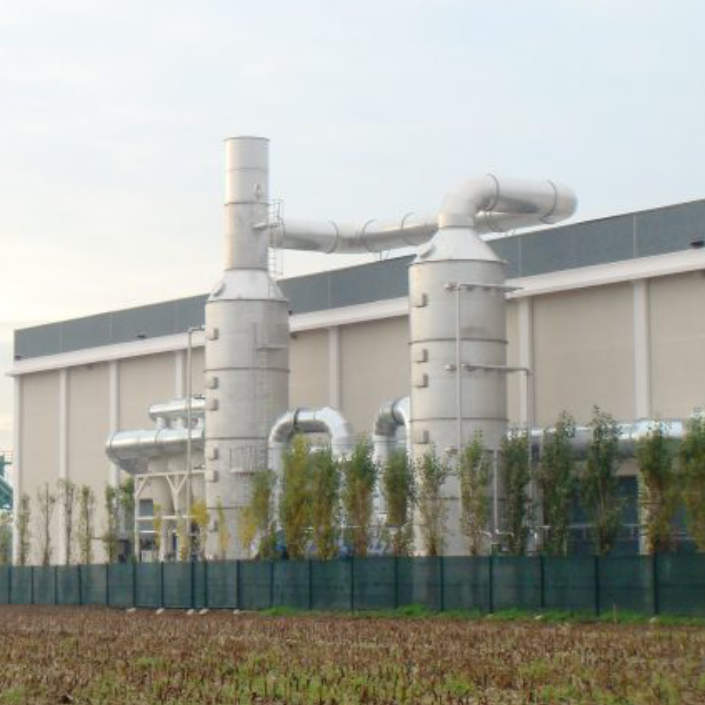SCRUBBERS
Scrubbers, also known as washing towers or wet scrubbers are air treatment plants where pollutants are removed using the principles of mass transfer between a gaseous and a liquid phase.
They are quite popular systems due to their versatility of application. Generally, scrubbers have the shape of a tower in which the purification process takes place by washing and by neutralization of harmful compounds presents in the polluted gas. Depending on the technology, scrubbers can be realized with (in this case scrubbers are called packed tower – see our SCR Ghibli series or without packing material (in this case scrubbers are called spray tower – see our SCR Monsoon series. Scrubbers with filling material can be realized with static or floating bed. Scrubbers allow the removal of both organic and inorganic compounds; for high removal yield, the use of suitable reagents (i.e., acids, bases, oxidants – depends on the type of contaminant to be removed) is mandatory. If no reagents are used, scrubbers are mainly aimed at humidifying the air flow (only high soluble compounds are removed). Scrubbers that use chemicals are equipped with appropriate probes so as to maintain an appropriate absorption driving force between the polluted air and the washing solution.
In the field of odour removal, the most used scrubbers are the so-called counter-current scrubber; this means that the flows of polluted air and the washing solution cross the tower with opposite directions (upward the air flow, downward the washing solution). Washing solution is taken from the vessel (generally located at the bottom of the tower) and pumped to the spray system (i.e., nuzzles) by means of a pump and a hydraulic circuit, generally made in polypropylene. Washing solution is recirculated until it is exhausted. Finally, in order to prevent droplets of liquid from exiting the tower with the exiting treated gas stream, clean air flow pass through a droplet separator (also called demister).
Scrubbers can operate as a single-stage or multistage systems; in this latter case, different chemicals are sequentially used for pollutants removal (for instance, first stage: sulphuric acid; second stage: sodium hydroxide).
BOUNDARY CONDITIONS / DESIGN PARAMETERS
- Flowrate ranges from 100 to 100,000 m3/hour per tower, multiple towers in parallel can be used for higher flowrates
- Odour loadings up to 1,000,000 ouE/m3 are common
- Soluble contaminants typically 50-200 ppm average, and up to 1,000 ppm peak
- Typical removal efficiency 99.5%, up to 99.95% as required
- Vessel diameters from 200 to 3,800mm, heights typically up to 10 m, or higher if the process requires it
APPLICATIONS AND PERFORMANCES
Chemical scrubbers are not effective for removing volatile organic compounds (VOCs) or other molecules, such as dimethyl disulphide. Scrubbers can be used successfully when a specific chemical pollutant has to be removed (e.g., ammonia) from the air flow. Scrubbers that use only water can be used as humidifiers (generally, placed before the biofilters).
Scrubbers are effective for odour control and for removing low-solubility gases, such as hydrogen sulphide. High removal yield (> 99%) can be reached for ammonia removal. If compared with biological systems (e.g., biofilters), scrubbers have a small footprint; vice versa, they are more expensive during the operation (e.g., chemicals are required, electro-mechanical equipment are operating) and for maintenance. Moreover, if chemicals are used for pollutant removal, safety issues for workers have to be evaluated.
ENERGY CONSUMPTION
Energy consumption depends on fan’s power, which are chosen according to the site conditions (e.g., ducts length and diameter). In addition, this system provides use of compressed air that can have a remarkable impact on the cost as well as the cooling/heating system, if necessary. Further energy saving potential can be tapped by the fluid dynamic optimization of the overall system. The selection of an appropriate packing in combination with its periodic cleaning are crucial issues to reduce energy requirements.
ENVIRONMENTAL FEATURES
Exhaust washing solution can be treated within the plant (i.e., where scrubber is operating) or disposed of. Generally, exhaust packing has to be disposed of. Chemicals have a moderate/high environmental impact.
RELATED PRODUCTS
- packing
- nozzles, sprinklers
- chemicals
- drops separator / demister
- electro-mechanical equipment.


 @airqualitymaker.com
@airqualitymaker.com @airqualitymaker.com
@airqualitymaker.com